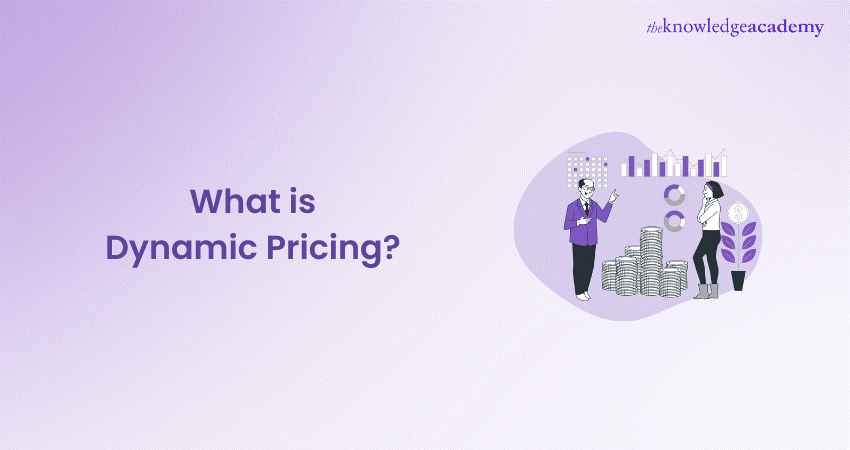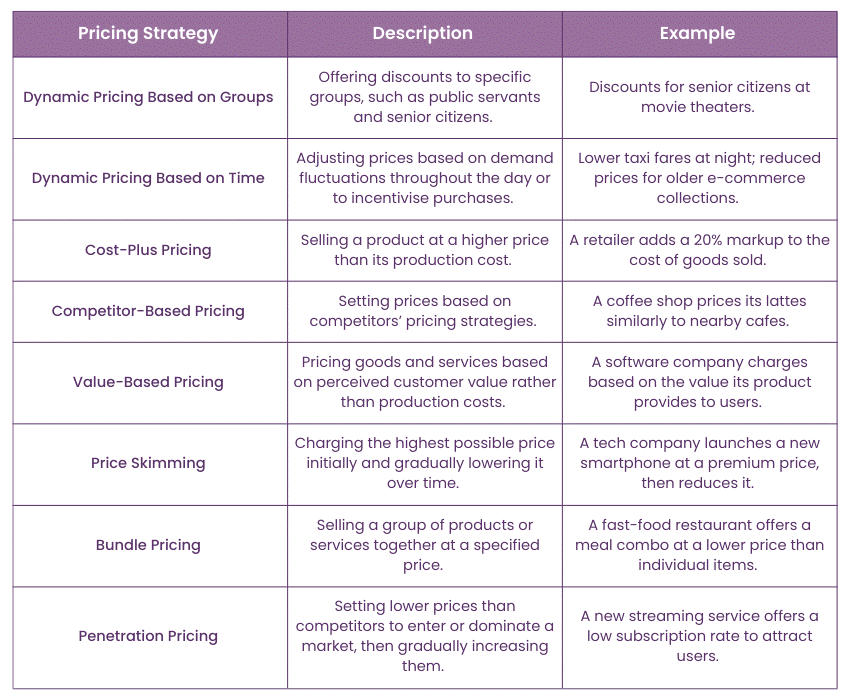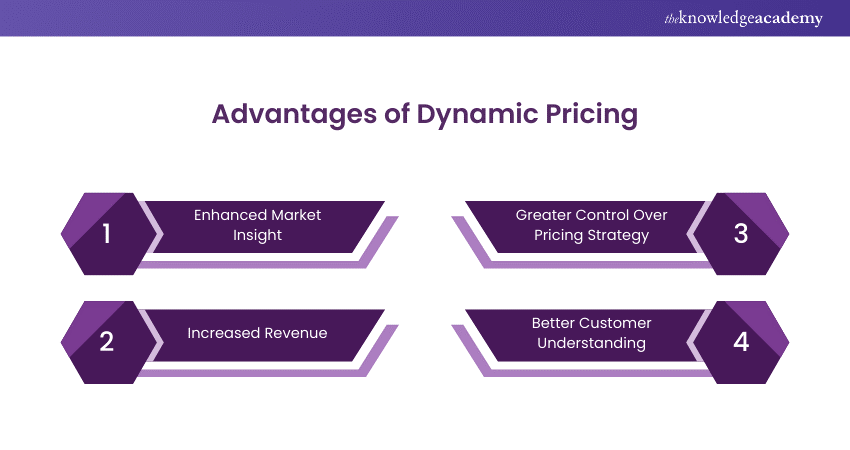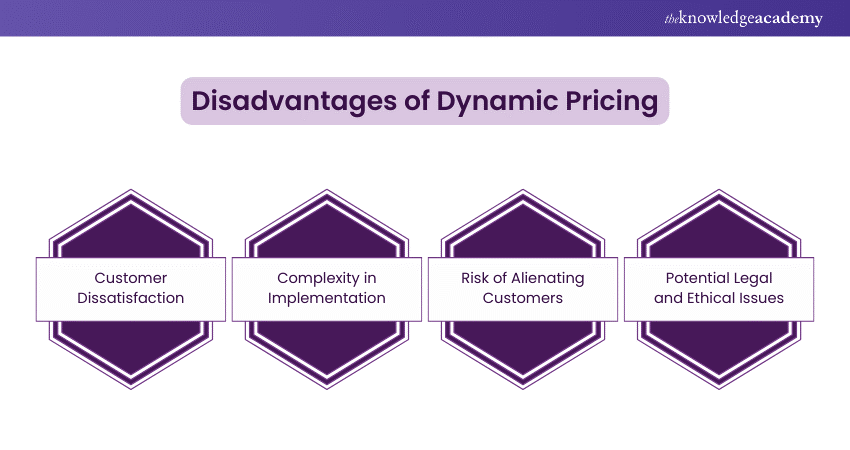We may not have the course you’re looking for. If you enquire or give us a call on 01344203999 and speak to our training experts, we may still be able to help with your training requirements.
We ensure quality, budget-alignment, and timely delivery by our expert instructors.

Dynamic Pricing is changing the way businesses set their prices. Gone are the days of fixed rates; now, organisations are adjusting their prices based on customer behaviour and market conditions. This not only keeps businesses competitive but also helps them in maximising profits and understand their customers better.
In this blog, we discuss the different types of Dynamic Pricing, real-world examples, and how you can implement this strategy effectively. Whether you're new to the concept or looking to refine your approach, this blog covers everything.
Table of Contents
1) What is Dynamic Pricing?
2) Types of Dynamic Pricing
3) Dynamic Pricing Examples
4) Advantages of Dynamic Pricing
5) Disadvantages of Dynamic Pricing
6) How to Implement Dynamic Pricing
7) Conclusion
What is Dynamic Pricing?
Dynamic Pricing is a strategy where the prices of products or services are adjusted based on changing market conditions. This approach considers factors such as:
a) Supply and demand
b) Competitor pricing
c) Inventory levels
Digital platforms leverage data analytics and technologies like artificial intelligence and machine learning to implement sophisticated algorithms. These algorithms analyse market conditions and predict the optimal pricing for products or services.
Types of Dynamic Pricing
Here are some of the Dynamic Pricing types:

Dynamic Pricing Based on Groups
This involves offering discounts to specific groups, such as public servants and senior citizens. It’s typically used for promotions and to cater to different price sensitivities.
Dynamic Pricing Based on Time
This strategy is common in businesses where demand fluctuates throughout the day. It can also be used to incentivise purchases. Examples include:
a) Lowering taxi fares at night to encourage usage.
b) Reducing prices of older collections in e-commerce to clear inventory.
c) Charging extra for same-day delivery in delivery services.
Cost-Plus Pricing
This straightforward method involves selling a product at a higher price than its production cost. Many organisations use this basic pricing strategy.
Competitor-Based Pricing
Here, a company sets its prices based on the pricing strategies of its competitors.
Value-Based Pricing
Companies price goods and services based on what they believe customers are willing to pay, considering the perceived value rather than just production costs.
Price Skimming
Price Skimming involves charging the highest initial price customers are willing to pay, then gradually lowering it over time. This approach targets different customer segments as the price decreases.
Bundle Pricing
Companies sell a group of products or services together at a specified price, rather than charging separately. This method can increase revenue by presenting a higher overall value.
Penetration Pricing
Often used by new entrants or businesses aiming to dominate a market, this strategy involves setting lower prices than competitors. Prices are gradually increased once a substantial customer base is established.
Dynamic Pricing Examples
Let's explore examples of Dynamic Pricing:
Hotels
Some hotels employ Dynamic Pricing as a strategy of changing the room prices depending on such factors as time and events. While choosing a hotel, it is essential to know that it can sharply raise the room prices during seasons and other relevant occasions but during low demand it can reduce the prices in order to get more clients.
Utility Providers
Some service industries like electricity providing companies apply Dynamic Pricing to regulate the supply and demand. One can set higher tariffs during high demand and lower tariffs during low demand thus attempt to control the time customers demand electricity.
Google Ads
Google Ads utilises Dynamic Pricing for its advertising platform through the use of a bidding approach. Advertisers purchase keywords and a bid per click and the amount one has to pay can vary depending on the keywords which have been used, time of day, etc. This makes it possible for the advertisers to set their budgets as well as fight for the space that is available.
Advantages of Dynamic Pricing
Here are the benefits of it:

1) Enhanced Market Insight
It brings a better understanding of market speculations and buyer’s behaviour to the businesses that implement Dynamic Pricing. In this way, the changes in customer reaction to prices help businesses identify how demand is likely to shift. It helps them arrive at rational pricing strategies.
2) Increased Revenue
Real-time adjustments of prices assist businesses in maximising their revenue. Charging high prices during peak demand means higher revenues, and offering low prices during low demand could also be beneficial in clearing the stock and attracting price-sensitive customers.
3) Greater Control Over Pricing Strategy
Dynamic Pricing allows businesses to take control of their pricing strategy by adapting to market changes. This flexibility ensures that prices are always aligned with current market conditions. It helps businesses stay competitive to customer needs.
4) Better Customer Understanding
Through Dynamic Pricing, businesses can better understand their customer's willingness to pay and purchase behaviour. This information can be used to customise marketing efforts and develop targeted promotions that resonate with different customer segments.
Get ready for your next role with top Management Interview Questions and Answers. Explore expert insights and ace your interview with confidence!
Disadvantages of Dynamic Pricing
Here are the disadvantages of it:

1) Customer Dissatisfaction
One of the significant risks of Dynamic Pricing is customer dissatisfaction. If customers notice that prices fluctuate frequently or feel they are being charged unfairly, it can lead to a loss of trust. This is particularly true if customers discover they paid more than others for the same product or service.
2) Complexity in Implementation
Implementing a Dynamic Pricing strategy can be complex and require sophisticated algorithms and technology. Businesses need to invest in the right tools and expertise to manage and analyse the vast amount of data required to make real-time pricing decisions.
3) Risk of Alienating Customers
Dynamic Pricing can alienate customers, especially if they perceive the pricing model as unfair or manipulative. This is particularly a concern for businesses that rely on customer loyalty and repeat business. Careful consideration must be given to how pricing changes are communicated to customers.
4) Potential Legal and Ethical Issues
There are legal and ethical concerns with Dynamic Pricing, particularly around price discrimination. In some regions, charging different prices to different customers for the same product might lead to legal challenges. Businesses need to be aware of the legal issues of their pricing strategies.
Learn to prioritise tasks with our Productivity and Time Management Course – Join today!
How to Implement Dynamic Pricing?
Implementing Dynamic Pricing means adjusting your prices based on market conditions and business goals. Here are some of the ways:
1) Define Your Commercial Objectives
Before implementing Dynamic Pricing, it's essential to define clear commercial objectives. Determine what you want to achieve, whether it's maximising revenue, improving market share, or optimising inventory. These objectives will guide your pricing strategy.
2) Select a Pricing Strategy
Choose the Dynamic Pricing strategy that best aligns with your business goals and market conditions. Whether it's time-based pricing, demand-based pricing, or competitive pricing, ensure that the strategy fits your commercial objectives and customer expectations.
3) Set Pricing Rules
Establish clear pricing rules that dictate how and when prices should be adjusted. These rules should be based on factors such as demand, competition, and market trends. It's essential to ensure that pricing changes are logical and transparent to avoid customer confusion.
4) Choose the Right Implementation Tools
Invest in the right tools and technology to implement your Dynamic Pricing strategy effectively. This may include pricing software and data analytics tools that allow you to track market conditions and adjust prices in real time.
Learn the tools for managing business with our Business Sustainability Course – Join today!
Conclusion
Dynamic Pricing is an effective tool that can be useful for businesses that aim to improve the price-setting process. This means that through changes in price competition, the availability of customers, segments, and market situations, firms attain more sales and competitiveness. However, Dynamic Pricing cannot be implemented easily or without prior planning and preparation. With the right strategy, Dynamic Pricing offers benefits that can be used to improve profitability and market responsiveness.
Get an understanding of the basics pricing with our Costing and Pricing Training – Sign up today!
Frequently Asked Questions
How can Businesses Avoid Customer Backlash From Dynamic Pricing?

To prevent customer backlash, companies should communicate their pricing change decisions effectively and provide proper rationales. They also have a chance to continue gaining customer loyalty through promotions or providing gifts to clients.
Can Small Businesses Implement Dynamic Pricing?

Yes, small businesses can implement Dynamic Pricing by using simple tools and strategies that adjust prices based on demand and competition. It can be a great way for them to stay competitive and boost profits.
What are the Other Resources and Offers Provided by The Knowledge Academy?

The Knowledge Academy takes global learning to new heights, offering over 3,000 online courses across 490+ locations in 190+ countries. This expansive reach ensures accessibility and convenience for learners worldwide.
Alongside our diverse Online Course Catalogue, encompassing 19 major categories, we go the extra mile by providing a plethora of free educational Online Resources like News updates, Blogs, videos, webinars, and interview questions. Tailoring learning experiences further, professionals can maximise value with customisable Course Bundles of TKA.
What is The Knowledge Pass, and How Does it Work?

The Knowledge Academy’s Knowledge Pass, a prepaid voucher, adds another layer of flexibility, allowing course bookings over a 12-month period. Join us on a journey where education knows no bounds.
What are Related Courses and Blogs Provided by The Knowledge Academy?

The Knowledge Academy offers various Management Courses, including the Costing and Pricing Training, Business Sustainability Course, and Productivity and Time Management Course. These courses cater to different skill levels, providing comprehensive insights into Budget Deficit.
Our Business Skills Blogs cover a range of topics related to costing, offering valuable resources, best practices, and industry insights. Whether you are a beginner or looking to advance your Dynamic Pricing knowledge, The Knowledge Academy's diverse courses and informative blogs have got you covered.
Upcoming Business Skills Resources Batches & Dates
Date
 Costing and Pricing Training
Costing and Pricing Training
Fri 25th Apr 2025
Fri 20th Jun 2025
Fri 22nd Aug 2025
Fri 17th Oct 2025
Fri 19th Dec 2025






 Top Rated Course
Top Rated Course



 If you wish to make any changes to your course, please
If you wish to make any changes to your course, please


